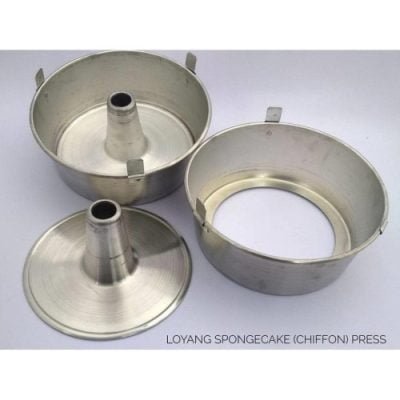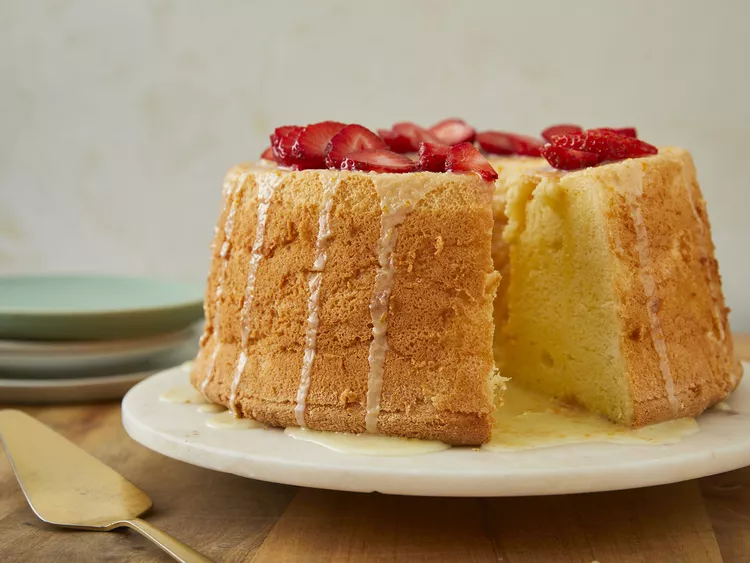Sponge cakes and chiffon cakes have similar shapes and appearances. Both have a sweet taste and can be paired with various creams, enhancing their flavor. When enjoyed with a cup of warm tea, their deliciousness doubles.
At first glance, many people consider these two cakes the same due to their similar appearance. Their textures are also alike. However, these two types of cakes are actually different. Here are the differences between sponge and chiffon cake!
Chiffon Cake
Chiffon cake is an extremely light cake made with vegetable oil, eggs, sugar, flour, baking powder, and flavorings. Being made with vegetable oil rather than traditional solid fats like butter, it’s easier to incorporate air into the batter.
Chiffon cakes sold today are often mistakenly interpreted as butter cakes and not served as per their original recipes. Chiffon cake falls under the category of foam cakes, made from egg whites, egg yolks, and vegetable oil. These ingredients maintain the cake’s texture, keeping it soft, moist, and fluffy, resulting in the best flavor.
History of Chiffon Cake
Chiffon cake was first made in the United States, specifically in Los Angeles, by a pastry chef named Harry Baker. The cake he made instantly became the talk of the town due to its delightful taste. Baker kept the recipe for 20 years until he eventually sold the chiffon cake recipe to General Mills, which popularized the cake on a larger scale in 1948.
The uniqueness of chiffon cake lies in the fact that after the main batter is made, you can add any flavoring, such as cheese, vanilla, chocolate, or even fresh fruits. Chiffon cake resembles a sponge cake but is denser and has a more substantial texture. Chiffon cakes are made using tube pans and can be steamed or baked in cupcake molds or pans.
Sponge Cake
Sponge cake is made from beaten eggs and sugar until they expand, then mixed with flour and melted margarine. Besides melted margarine, sponge cake can also be made with oil instead of melted margarine. According to Master Class, the foamy egg structure in sponge cake allows it to rise without baking powder or baking soda. Sponge cake’s ability to absorb moisture easily also makes it popular as a base for desserts like tres leches cake and trifle.
Sponge cake batter can be cooked in two ways, either by baking or steaming, for 30-40 minutes at 180 degrees Celsius. Sponge cake or butter cake can be enjoyed after it’s cooked and is suitable for serving with coffee or hot tea.
History of Sponge Cake
Sponge cake was first discovered by Italian pastry chef Giovan Battista Cabona (Giobatta) in one of the Spanish palaces alongside his master, Marquis Genoa Domenico Pallavicini, around the mid-16th century. Using simple ingredients like eggs, sugar, and flour, the pastry chef managed to create a soft and light cake.
This type of sponge cake involves beating eggs and sugar first until they expand perfectly, then adding other ingredients like flour, and finally mixing the batter with previously melted butter. The number of eggs used greatly influences the texture and softness of this type of cake.
In making sponge cake, several factors should be considered, such as how to mix flour and butter. The safest method often used is folding or folding back. With a gentle upward motion using a spatula, until all the batter is evenly mixed. If mixed incorrectly, the cake won’t rise and will become dense, caused by the accumulation of melted butter at the bottom of the batter.
Differences Between Chiffon and Sponge Cake
Chiffon cake and sponge cake are often thought to be similar, but in reality, they are different. Now let’s discuss the differences between chiffon cake and sponge cake, as explained below:
- Different Textures
At a glance, they may seem similar. However, you can immediately tell the difference between the two cakes by their textures.
Sponge cake is much denser and slightly drier. This is influenced by the type of fat used in the batter.
On the other hand, chiffon cake has a lighter and moister texture. In fact, it feels softer and more elastic when bitten, making it more preferable.
However, it doesn’t mean that sponge cake isn’t soft. Sponge cake remains soft when eaten, but it just feels heavier when chewed.
- Use of Fat
The use of fat in these two cakes is very different, thus affecting the texture when they are cooked. Chiffon cake uses liquid fat in the form of oil.
This cake doesn’t use butter. That’s what makes chiffon texture softer and not heavy when eaten. Additionally, the use of egg whites also plays a crucial role in creating a soft texture in chiffon cake.
Meanwhile, sponge cake uses fat in the form of egg yolks, typically around eight of them. Not only that, but this cake also incorporates approximately 200 grams of butter in the batter. This is what makes sponge cake texture much heavier and denser, yet still soft.
- Difference in Preparation
When making sponge cake, you can beat and mix all the ingredients directly. However, still do it gradually.
First, beat eggs, sugar, and baking powder. Once beaten until expanded, dry ingredients can be added.
In contrast, the process of making chiffon cake batter must be done separately and in two parts. The first part consists of beaten eggs with sugar, oil, and dry ingredients like flour.
The second part involves beating egg whites with sugar until thick and white. Then, gradually fold the egg white mixture into the egg yolk mixture.
Tips for Using Chiffon Pans Correctly
Did you know there’s a specific pan for chiffon cakes?
Huh? Is there a special pan for chiffon cakes? Yes, there’s a specific chiffon cake pan, especially for those who are new to making chiffon cake, it’s better to use a specific chiffon cake pan like the one shown in the picture below:

The uniqueness of Chiffon Cake is when the cake is cooked, the pan containing the cooked cake must be immediately removed from the oven, and the pan must be flipped over onto the table. This prevents the chiffon cake from collapsing during the cooling process. That’s why the walls of the chiffon pan should not be greased with butter or margarine to prevent the cake from deflating when the pan is flipped.
The legs on the pan hold the top of the chiffon, which usually bulges and cracks, touching the table and also provide air circulation space.









 ID
ID